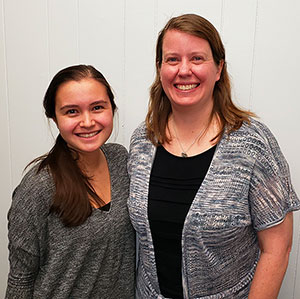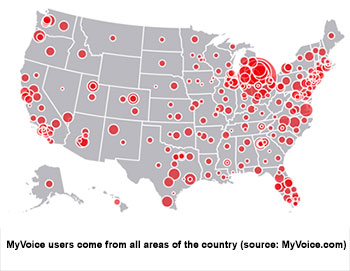A New Research Tool to Hear Adolescent Voices
 NDSU associate professor of human development and family science Beth Blodgett Salafia and doctoral graduate research assistant Kerrie Leonard study adolescent body image issues. Utilizing MyVoice, a tool developed at the University of Michigan that Leonard first learned about during her time working as a research assistant, Salafia and Leonard are collecting data directly from individuals aged 14-24. MyVoice is an interactive tool built on an SMS platform that gathers the opinions and experiences of youth across America. Through real-time text message polling, MyVoice can reach adolescents quickly via a platform they are already utilizing.
NDSU associate professor of human development and family science Beth Blodgett Salafia and doctoral graduate research assistant Kerrie Leonard study adolescent body image issues. Utilizing MyVoice, a tool developed at the University of Michigan that Leonard first learned about during her time working as a research assistant, Salafia and Leonard are collecting data directly from individuals aged 14-24. MyVoice is an interactive tool built on an SMS platform that gathers the opinions and experiences of youth across America. Through real-time text message polling, MyVoice can reach adolescents quickly via a platform they are already utilizing.
“MyVoice is a great tool for reaching adolescents,” commented Leonard. “Researchers can use the tool to get real-time responses on a number of youth priorities including health, nutrition, and social media. As surveys are completed privately via cellphones and respondents receive a small stipend for every opinion they share, it’s easy to get them to participate and many do.” MyVoice has sent nearly 300,000 text message questions to 1,551 participants across 1,142 unique Zip Codes. Participants are paid $1 a week to answer three to five open-ended questions related to a specific topic.
Leonard is currently in the second year of her PhD program. Her Master’s thesis will use the MyVoice data to focus on adolescent body image issues and the impact of social media on them. While positive social media challenges like the ALS Association ice bucket challenge exist, many others are related to specific body image ideals.
“The Kylie Jenner lip challenge directs participants to cause their lips to swell by creating a vacuum around their lips using a glass and another directs participants to measure their waists by comparing it to the width of a standard piece of A4 paper,” notes Leonard. “Yet another directs participants to show a gap between their thighs when their legs are together. Participants are directed to post the results of each challenge and use hashtags which helps to propagate them virally. Many challenges feature potentially harmful activities and a commonality across all of them relate to a specific type of idealized body image, which sets an oftentimes unachievable goal for adolescents.”
 “While social media body image challenges are widespread, very little has been done to research them,” said Salafia. “With new challenges appearing constantly, MyVoice gives us the perfect platform to quickly engage with a group who are aware of them and many who have been impacted by them already.” Leonard added, “I want to help the individuals in our communities counter these potentially harmful activities. By understanding them, we can help develop defenses for the individuals who are negatively affected.”
“While social media body image challenges are widespread, very little has been done to research them,” said Salafia. “With new challenges appearing constantly, MyVoice gives us the perfect platform to quickly engage with a group who are aware of them and many who have been impacted by them already.” Leonard added, “I want to help the individuals in our communities counter these potentially harmful activities. By understanding them, we can help develop defenses for the individuals who are negatively affected.”
Salafia and Leonard are also interested in the development and impact of positive social challenges. “We’re starting to see social challenge alternatives like Don’t Judge Me or the No Makeup Challenge. I’m interested in learning how they will impact youth as well,” Leonard stated.
Supported through grants awarded to Salafia from the NDSU Office of Research and Creative Activity and the college of Human Development and Family Science, Salafia and Leonard used MyVoice to poll their research audience. They first designed and developed specific questions and conducted pilot testing. The questions were then distributed to youth across the country. “We received our results in only a few days,” said Leonard.
Salafia and Leonard are currently brainstorming a plan for sharing the data they collected and sum up their work simply as lifting up voices. Salafia appreciates the approach and methods of her graduate student. “I asked Kerrie what she wanted to accomplish with her work. She said that she wants to reach people, to inform policy makers, and to share the information with parents which are goals that I share in my research.”
Salafia, currently in her 12th year at NDSU, studies factors related to risk and body image issues. She has researched how these images can cause unhealthy behaviors and she connects that with what can be promoted to encourage a more healthy relationship with our own bodies. She has studied body image ideals through focus groups and how U.S. culture creates and changes them. “This is important to learn, including from the perspective of our international students,” she adds.
Leonard sees her future in research or perhaps higher education. “Research is a passion for me and developmental science is broad,” she says. “I came to NDSU because of Dr. Salafia and I appreciate being a part of her lab. She’s the best!”
Learn more about MyVoice


